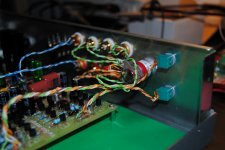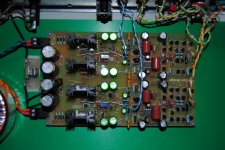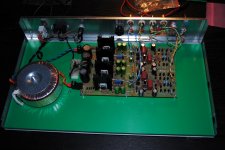Today I connected the gainwire to my singleton lateral mosfet amp "Assemblage" and was up to some serious revelations.
The Assemblage is quite fast and unforgiving so I could easily detect the differences between preamps.
After listening to the AQ2001 tube pre that I have in repair mode, I switched to my "old" Pedja buffer and got some improvements in speed and detail.... when I switched to the gainwire I was really impressed. It is much faster and more detailed than the previous ones but always musical.... not analytical at all.
Focusing on your design, I listened repeatedly to some reference recordings using NGNF and Current feedback and everytime I much preferred the NGNF. In fact the feedback tightens things up but immediately looses poise and high freq detail.
Using feedback this amp sounds slightly better than an opamp but not that much better IMO.
Feedback seems to erase fluidity and spatiality.
Without feedback this amp is something special. It has almost the same stage width than the DCB1 with more detail and slam.
The longer I listen to it the better it becomes..... Now I must really convert it to 3.5dB by reducing R17 to 1k5 but I have a doubt... should I also increase C2 to 220p ?
Why do we need to increase capacitance if having less gain ?
Don't forget to change R19 from 100R to 330R too. C2 was increased to 220pF in 3.5x (11dB) to get better Phase margin in CFA mode, but you can try with 100pF, phase margin is still good at 68 degree. It does not influence non GNFB mode to much.
By the way what kind of volume potentiometer you use? With the best quality as ELMA stepped attenuator you can get much more from this preamp.
Last edited:
Was there ever an SMD version of of this preamp built?
Not from my side, but I hope it will be in near future.
I'll see what I can come up with and post some pictures then.
That will be very nice.
Here we are.
During my latest listening session with a ZYX bloom cart and a Nagra pyramid poweramp, I noticed some sibilance.... probably due to cart misalignment.... this preamp is ruthless.
But the soundstage was huge and the transients really fast.... will need to replace the rectifying diodes and the volume pots.
No hum, no hiss... perfectly silent in operation.
During my latest listening session with a ZYX bloom cart and a Nagra pyramid poweramp, I noticed some sibilance.... probably due to cart misalignment.... this preamp is ruthless.
But the soundstage was huge and the transients really fast.... will need to replace the rectifying diodes and the volume pots.
No hum, no hiss... perfectly silent in operation.
Attachments
Here we are.
During my latest listening session with a ZYX bloom cart and a Nagra pyramid poweramp, I noticed some sibilance.... probably due to cart misalignment.... this preamp is ruthless.
But the soundstage was huge and the transients really fast.... will need to replace the rectifying diodes and the volume pots.
No hum, no hiss... perfectly silent in operation.
It looks good. Why do you want to replace rectifying diodes?
By the way you have some good equipment there.
I am quite well connected so I am able to listen with some very interesting electronics.
The rectifying diodes have a major role in SQ principally using this type of shunts (I built more than 20 variations on this theme).
Rectifying diodes, smoothing caps and the TX themselves are quite important when using these marvellous shunts.
Instead of using a zobel between the TX and the diode bridge I always found that using HEXFREDS provide the best results. The major differences are in the treble and it is there that this preamp excels.
The rectifying diodes have a major role in SQ principally using this type of shunts (I built more than 20 variations on this theme).
Rectifying diodes, smoothing caps and the TX themselves are quite important when using these marvellous shunts.
Instead of using a zobel between the TX and the diode bridge I always found that using HEXFREDS provide the best results. The major differences are in the treble and it is there that this preamp excels.
I am quite well connected so I am able to listen with some very interesting electronics.
The rectifying diodes have a major role in SQ principally using this type of shunts (I built more than 20 variations on this theme).
Rectifying diodes, smoothing caps and the TX themselves are quite important when using these marvellous shunts.
Instead of using a zobel between the TX and the diode bridge I always found that using HEXFREDS provide the best results. The major differences are in the treble and it is there that this preamp excels.
Could you explain how you use HEXFREDS, I would like to learn new thing, new at least to me. I used some extra fast soft recovery diodes too.
I found that using HFA15PB60 intead of the "usual" schottky produces a fast but less edgy sound in low power applications.
The soft recovery characteristic impairs the TX tendency to oscillate at high frequencies during diode shut down periods so I do not need the "taming" zobels that (if not precisely done) can dull the sound.
Another very important part is the smoothing cap..... initially I was convinced that the shunt would be impervious to the TX / diode / cap combination before it because it works with a CCS with very high PSRR, but that is not true.
Smoothing caps can easily be heard before the shunts. The effect / difference is quite dramatic. You can experiment just by bypassing the smoothing cap with some styrenes.
IMO bypassing is quite an art and in the psu is very difficult to tame so the best bet is to use 4 pole caps with high capacity. Sounstage width increases enourmoulsly when using some special models.
Another area I did not "touch" yet id the termination of the shunts..... you use a 100u 0.1r zobel but I believe your shunts could stand a 0.2r 4.7u film.... what do you think ?
The soft recovery characteristic impairs the TX tendency to oscillate at high frequencies during diode shut down periods so I do not need the "taming" zobels that (if not precisely done) can dull the sound.
Another very important part is the smoothing cap..... initially I was convinced that the shunt would be impervious to the TX / diode / cap combination before it because it works with a CCS with very high PSRR, but that is not true.
Smoothing caps can easily be heard before the shunts. The effect / difference is quite dramatic. You can experiment just by bypassing the smoothing cap with some styrenes.
IMO bypassing is quite an art and in the psu is very difficult to tame so the best bet is to use 4 pole caps with high capacity. Sounstage width increases enourmoulsly when using some special models.
Another area I did not "touch" yet id the termination of the shunts..... you use a 100u 0.1r zobel but I believe your shunts could stand a 0.2r 4.7u film.... what do you think ?
I found that using HFA15PB60 intead of the "usual" schottky produces a fast but less edgy sound in low power applications.
The soft recovery characteristic impairs the TX tendency to oscillate at high frequencies during diode shut down periods so I do not need the "taming" zobels that (if not precisely done) can dull the sound.
Another very important part is the smoothing cap..... initially I was convinced that the shunt would be impervious to the TX / diode / cap combination before it because it works with a CCS with very high PSRR, but that is not true.
Smoothing caps can easily be heard before the shunts. The effect / difference is quite dramatic. You can experiment just by bypassing the smoothing cap with some styrenes.
IMO bypassing is quite an art and in the psu is very difficult to tame so the best bet is to use 4 pole caps with high capacity. Sounstage width increases enourmoulsly when using some special models.
Another area I did not "touch" yet id the termination of the shunts..... you use a 100u 0.1r zobel but I believe your shunts could stand a 0.2r 4.7u film.... what do you think ?
I am not sure, my ears are quite old and I am afraid I could not hear the difference, and here I don't have young audio enthusiast to help me with this. Maybe you can experiment and tell the result?
Young audio enthusiast ?
Old ears ?
I was born in 57... remember 250 GTO ?
I am not old, mind you.
You are not old, you are knowledge full.... I wish I knew 1/500 of what you have to give.
PS: The truth is I am getting blind and in return nature is giving me back an exceptional hearing capability. I can detect the nuances of the different components sonic signature easily.... but I am having increasing difficulties with soldering....
Old ears ?
I was born in 57... remember 250 GTO ?
I am not old, mind you.
You are not old, you are knowledge full.... I wish I knew 1/500 of what you have to give.
PS: The truth is I am getting blind and in return nature is giving me back an exceptional hearing capability. I can detect the nuances of the different components sonic signature easily.... but I am having increasing difficulties with soldering....
Last edited:
Young audio enthusiast ?
Old ears ?
I was born in 57... remember 250 GTO ?
I am not old, mind you.
You are not old, you are knowledge full.... I wish I knew 1/500 of what you have to give.
Still, you are 13 years younger then me, my hearing is not gone to much but not so good as 13 years ago.
And you are to kind.
RCruz, you should try a good SMPS, one of these days.
Can you suggest something I could build or get already built ?
What would the collector current be on Q13?
About 29 mA, defined with R30 and R31 values.
- Status
- Not open for further replies.
- Home
- Amplifiers
- Solid State
- No NFB line amp (GainWire mk2)



